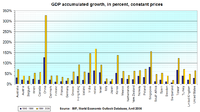
Photo from wikipedia
Abstract Our understanding of how simultaneous climate warming and changing precipitation influence plant phenology in grasslands is still limited. As part of a field transplant experiment, this study was conducted… Click to show full abstract
Abstract Our understanding of how simultaneous climate warming and changing precipitation influence plant phenology in grasslands is still limited. As part of a field transplant experiment, this study was conducted to explore the flowering phenology of the dominant species in three temperate steppes (i.e. a desert, typical, and meadow steppe) along a precipitation gradient in response to simulated night warming and precipitation manipulation (i.e. decreased, ambient, and increased precipitation). Of all monitored species and across three growing seasons (2015–2017), night warming advanced flowering date in the desert and typical steppes, but delayed it in the meadow steppe. Decreased precipitation postponed flowering date but increased precipitation advanced it in all the three steppes. Plant growth largely determined the changes in flowering date under night warming and changing precipitation across and in each of the three steppes. The dominant role of plant growth in modulating reproductive phenology provides mechanistic understanding in interpreting phenological response and facilitate the projections of response of temperate grasslands under future climate change scenarios.
Journal Title: Agricultural and Forest Meteorology
Year Published: 2019
Link to full text (if available)
Share on Social Media: Sign Up to like & get
recommendations!